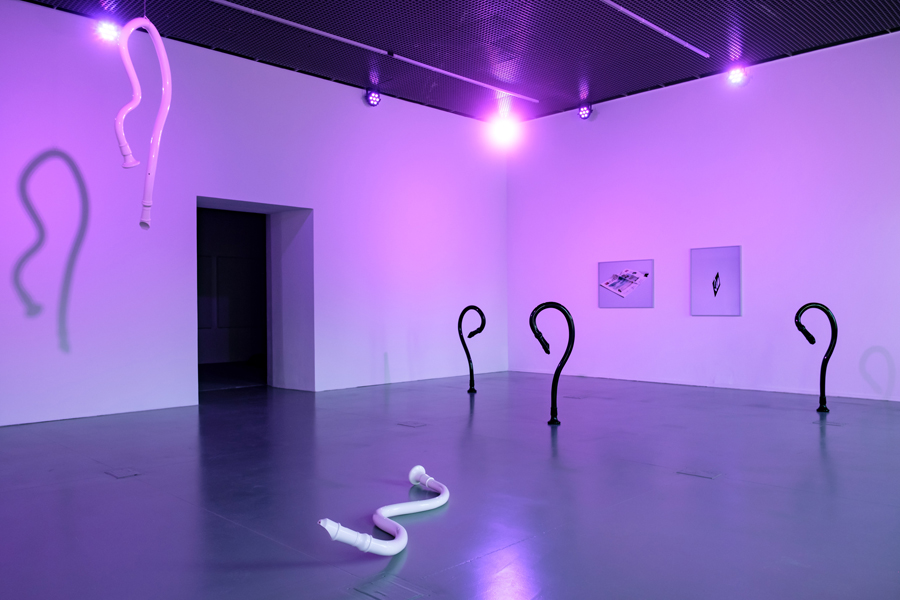Assaf Gruber: Spreading Rumours
The artist explores the interplay between fact and fiction, and the individual versus the collective, at Ujazdowski Castle CCA, Warsaw
The artist explores the interplay between fact and fiction, and the individual versus the collective, at Ujazdowski Castle CCA, Warsaw

A woman in her mid-30s cuts off a conversation with a woman she met earlier in the day: ‘Maybe our world doesn’t need our stories. Maybe our world is doing just fine without a plot.’ Sitting in a Finnish sauna, they fall silent, their faces beaded with sweat. The two characters, the protagonists of Assaf Gruber’s film The Conspicuous Parts (2018), are enmeshed in a web of narratives. The second, Catherine, is collecting material for a novel about a 1960s diving expedition that supplied Berlin’s Natural History Museum with ten metres of coral reef from Cuba; the coral also played a part in a recent love affair that left her heartbroken. The first, Daphne, a taxidermist at the museum, is obsessed with the natural-history dioramas that were commissioned by the museum’s former director, who demanded that his funeral ceremony be held in front of one of them. It is said that his ashes rest underneath the artificial alpine landscape.
Such fictional stories, choreographed and endlessly looped, spilling over one another and clinging to our world in the least expected of ways, are at the heart of ‘Rumour’, the first large-scale show to feature both Gruber’s films and objects. In the sauna, Daphne observes: ‘Each time I enter this kind of place, I can’t help thinking of Hundstage [Dog Days],’ referring to Ulrich Seidl’s 2001 film. Another, purely visual reference to the Austrian director’s work is found in The Calling (2017), where Daphne’s voiceover accompanies the daily routines of her father, an unfulfilled artist who was repeatedly rejected from the Dresden Academy of Fine Arts. The slow-paced, outdoor shots imbue his quotidian caretaker’s duties – brushing and rolling a tennis court, sanitizing a pool – with a sinister quality.

Gruber’s works are less alternative universes than thresholds through which filmic reality seeps into ours – the visitor observes The Conspicuous Parts from a custom-made sauna bench. For ‘The Conspicuous Parts’ (2018), a series of photographic still lifes, fragments of coral reef from Cuba were shot amidst the Natural History Museum’s German Democratic Republic-era dioramas. Feudalistic Values (2015) is a photograph of a front page of the German newspaper Die Zeit that also appears in Gruber’s film The Right (2015), a monologue addressed to the director of the Muzeum Sztuki in Łódź by a retired invigilator from Dresden’s Gemäldegalerie Alte Meister, in which she expresses her disenchantment with old-master painting and declares allegiance to a.r., a leftist avant-garde group in interwar Poland. ‘Today’, she declares, ‘individualism has replaced collectivism. Everybody claims to be “proletariat”, but they are prisoners of feudalistic values exactly like the old masters were.’ Next to Feudalistic Values is another photograph: Untitled (Postcard) (2015), a tilted, black and white image of Władysław Strzemiński, the leading figure of a.r.. Here, he is downscaled, distorted, somehow helpless when considered against the adjacent headline of Die Zeit: ‘End of the White Man’.

On view in a separate room, Two Gentlemen (2012) comprises a looped film snippet of a man facing a window and a reproduction of the Hasidic Jewish man in Bruno Schulz’s painting, The Meeting (1920). The two figures eye each other as they perform what seem to be erotic gestures. ‘Rumour’ shows how Gruber’s art-historical and filmic sources – which his earlier works, notably the ‘Studies in Sculpture’ series (2004–12), used directly – are now woven into his cinematic narratives, as in his references to the films of Seidl.
Gruber’s recent films are thick with stories of individuals engaging unlikely encounters within an artistic and institutional context. Most compelling, however, is the fundamental disconnect between the image, the dialogue and the framing commentary that lays bare how we latch on to bits of information, whether rumoured or verified, in order to make sense of the world. While the latter may be doing just fine without a plot, we retain an inherent urge to be part of one.
Main image: Assaf Gruber, 'Rumor', 2018, installation view, Ujazdowski Castle Centre for Contemporary Art, Warsaw. Courtesy: the artist and Ujazdowski Castle Centre for Contemporary Art, Warsaw; photograph: Bartosz Górka






















